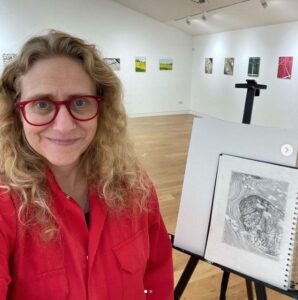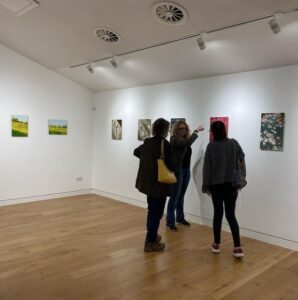ALISON BERRY Solo Show
Car parks & fairy rings
25 August – 11 September
Drop in and chat to the artist, Alison will be painting in the Gallery every Friday and Saturday 10 – 4
Car parks and fairy rings
A combination of the everyday and peculiar, this collection of paintings is a reflection of Alison’s life during Covid-19 lockdown; the almost daily walks along country roads, car parks or things observed in her own home. No hierarchy exists in this medley of subjects so that the rear end of a recently washed Ford Focus covered in soap suds happily sits alongside a rural scene with fairy rings in the grass. No subject is too strange, which results in an undercurrent of humour; the paintings of squashed horse manure with car tyre track imprints spring to mind.

Alison sees first and then identifies later. Initially caught by abstract shapes such as grids or perhaps extreme contrasts in tone, only afterwards does she identify the subject matter. She is an annoying person to accompany on walks, constantly stopping to look at random objects. Even her outwardly representational paintings will have had an abstract hook which drew her in. It’s probably no coincidence that a book of great importance to Alison is “Seeing Is Forgetting the Name of the Thing One Sees” by Lawrence Weschler about the artist Robert Irwin.
These are painterly paintings and her emphasis is to let the paint do the work with sometimes crude and playful brush marks. This can mean that the observer has to work quite hard, looking through the paint to put themselves in the place where Alison was when she conceived the painting, whether that be hovering over a puddle in a pothole or standing in a B&Q car park staring at the white lines on the tarmac. She hopes the observer experiences a travelling sensation; a movement between awareness of paint, subject matter and of physical place in a kind of heterotopic merry-go round. Luc Tuymans said the reason why we paint is because we can’t hold everything in our heads. Alison has embedded this approach into her practice so that she judges the success of a painting by whether it surprises her, even after many times of looking.

Alison feels guilty for not being ‘relevant’ and the subject matter of her work may seem disconnected to the tumultuous events of the last 18 months. However seeking solace in common place objects is not an unusual response. Arthur C Danto noted the tendency for American artists to paint humble subject matter in the aftermath of the terrorist attacks of 9/11. It is a privileged distraction but there is deep pleasure in the everyday and the observer is invited to engage and enjoy.





